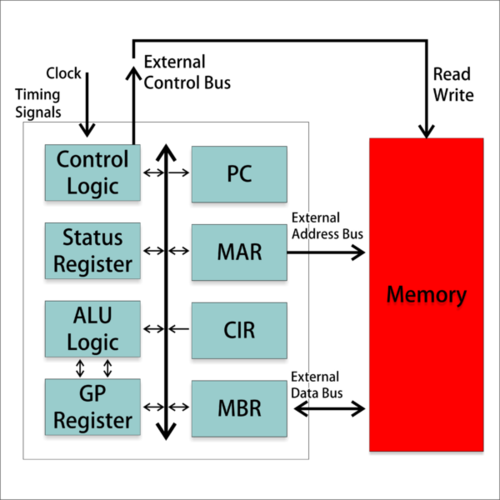Difference between revisions of "Processor Fundamentals"
(→Role of the Processor) |
|||
| Line 1: | Line 1: | ||
| − | =Role of the Processor= | + | =Role of the Processor & Components= |
The processor is a major part of the computer. It is required to sequence operations and give commands. It also controls the memory of the computer as well as perform simple tasks and operations such as basic mathematical problems. | The processor is a major part of the computer. It is required to sequence operations and give commands. It also controls the memory of the computer as well as perform simple tasks and operations such as basic mathematical problems. | ||
Revision as of 09:54, 11 June 2018
Contents
[hide]Role of the Processor & Components
The processor is a major part of the computer. It is required to sequence operations and give commands. It also controls the memory of the computer as well as perform simple tasks and operations such as basic mathematical problems.
https://www.youtube.com/watch?v=IksflGq6Vbw&index=114&list=PLCiOXwirraUDUYF_qDYcZV8Hce8dsE_Ho
Program Control Unit
The program control unit fetches instructions from the main memory and executes them one at a time.
Arithmetic Logic unit
The ALU performs all logical operations on data, such as addition and subtraction, fixed or floating point arithmetic, and Boolean logic and shift operations.
Clock Speed
Clock speed is the number of clock pulses per second or cycles per second. It is measured in Hertz (Hz).
Word Length
Word length is the number of bits in each of the registers in the processor. Word length determines the size of data or addresses that can be processed in one operation. If data exceeds the word length, this causes an overflow and extra processing is needed.
Bus Width
The bus width is the number of signal wires in the bus, which affects how many bits it can transfer at a time in parallel. A 16-bit bus has 16 wires to transfer 16-bits at a time and 32-bit buses have 32 wires, etc. All buses also have their own clock speed, to make sure all the bits sent are synchronised and arrive at the same time and in order.
Registers
Registers are fast memory locations on the processor. They store data or instructions that are currently in use by the processor.
https://www.youtube.com/watch?v=77LMgOGoNPs&index=116&list=PLCiOXwirraUDUYF_qDYcZV8Hce8dsE_Ho
General Purpose Registers
General purpose registers do not store any specific type of information, but instead temporarily hold general information as well as instructions.
Dedicated Registers
Dedicated registers store a specific type of information, chosen by the processor and not the programmer.
Program Control Unit Registers
Program Counter
The Program Counter (PC) holds the memory address of the next instruction.
Current Instruction Register
The Current Instructions Register (CIR) stores the instructions and commands to be executed on the next clock cycle of the CPU.
Stack pointer
The stack pointer (SP) takes data and puts it into a "stack". The data is figuratively put into a stack where the data that was most recently received will be on the top of the stack. When another component wants to request information from the SP, it can only take the data from the top of the stack, in a "last in, first out" order.
Status Register
The status register (SR) displays the state of the processor. This can be things such as overflowing, positive or negative outcome, full or working properly.
ALU Registers
Accumulator
The Accumulator or ACC will hold the current set of calculations. This information is then retrievable later on.
Memory Registers
Memory Address Register
This register stores the address of the memory location to be read from or written to.
Memory Buffer Register
This is the register containing data being retrieved or sent to the currently accessed memory location.
